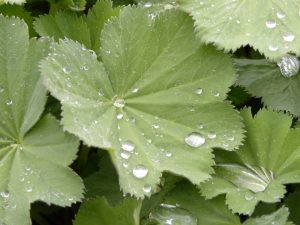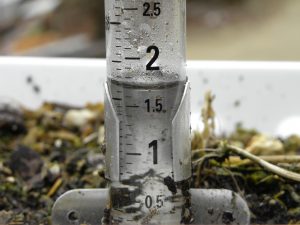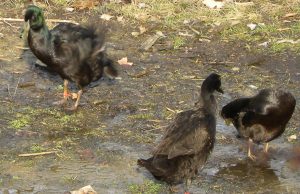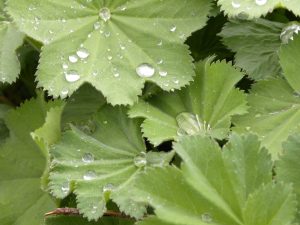I’m thrilled to announce: the drought is over for us as of May 9 after 24 months! Which inspires me to write in praise of rain.
Here in NH we are in the midst of weeks of intermittent rain. A few downpours, even some thunder and lightning, but predominantly light precipitation that doesn’t flood us but soaks into the earth.

Lady’s Mantle in the Rain
Sure, it doesn’t help our solar power, grey days can feel dreary, and warm sunny days interspersed for pollinating would be ideal… but after months, nearly years, of drought I welcome each drop.
Not everyone realizes that drought conditions continued here until May 9, 2017. Winter snow melt improved surface water enough that visual cues were fewer. However, as a person with The US Drought Monitor bookmarked on my computer, I saw that we were not back to normal.
In reviewing the archived drought maps, our Autumns of 2013 and 2014 were “abnormally dry,” a sort-of pre-drought condition, but were resolved by winter snows. Then, starting on May 12, 2015 we had a full year of fluctuating between “abnormally dry” and “moderate” drought. On July 12, 2016 we hit “severe” status then climbed to “extreme” as of August 30, 2016, lasting until November. This year’s winter snows were not enough to shift us out of “severe.” It was in late March that, finally, regular rains, drop by drop, along with cool temperatures, eventually resulted in this week’s return to normal. While it’s no guarantee, NOAA predictions look promising for a good growing season, while NH state officials are still encouraging caution, especially for those of us depending on our own wells for water. In the local permaculture community we are discussing water management systems, now that we see both too much and too little water as likely problems in our future.

Rain Gauge – Nearly 2 inches over 2 days!
Looking beyond this larger concern… a rainy spring has also been a great opportunity for getting new plants started!
In the annual garden, the small seeds of carrots, beets, parsnips and radishes love to get going in moist conditions. Cover and pasture crops also thrive. We disturbed soil to build a new barn last year, which I now have the chance to reseed with a mix of perennials for pasturing the animals on. In our orchard areas, we have cut swales and created berms for water retention over the past few years, followed by hugelkultur mounds topped with thick (at least 1 inch) mulches to build soil. Now, I am establishing more perennial herbaceous plants around the young fruit trees and bushes. For instance, red clover and lupines for below ground nitrogen feeding to microorganisms and plants, and borage and cleome to offer nectar and pollen to the pollinators above.

Ducks always appreciate water!
While I can water in dry times, I find good natural conditions produce better results.
I remember watching the sky and the weather forecast last year, feeling helpless and vulnerable. It was humbling to have my human illusion of being in control and self-sufficient challenged, to be reminded that we are just a small part of a much larger system.
Sometimes that’s a relief as well. As Vandana Shiva says: “You are not Atlas carrying the world on your shoulder. It is good to remember that the planet is carrying you.”
During this appropriately rainy spring, I am grateful to be the recipient of such generosity.

Lady’s Mantle


